 Estimating Edge’s team of experienced construction professionals and software engineers have developed the industry’s smartest takeoff and estimating software solutions for competitive estimates.
Estimating Edge’s team of experienced construction professionals and software engineers have developed the industry’s smartest takeoff and estimating software solutions for competitive estimates.
Don’t just estimate faster. Estimate better.®
- /
- /
- /
Excavation Calculations
This is an overview of how The EDGE calculates excavation. This is intended so users can understand the condition results and adjust as needed in the condition properties to account for different methods they may have.
Angle of Repose
When we mention “angle of repose,” we are referring to the angle for excavation purposes as shown in the figure below.
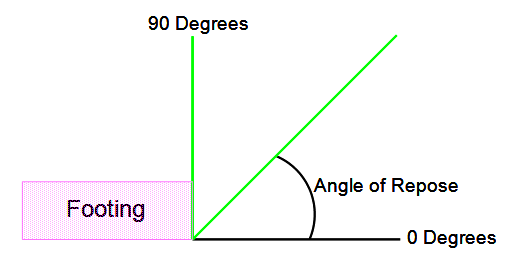
You can enter a whole number between 0 and 90 degrees. Both 0 or 90 will be considered a straight vertical line and not add any for the angle of repose. Any other number between them will be calculated based on the above figure.
Wall Footing Length Along Sides
Here is a plan view of a wall footing excavation along the sides.
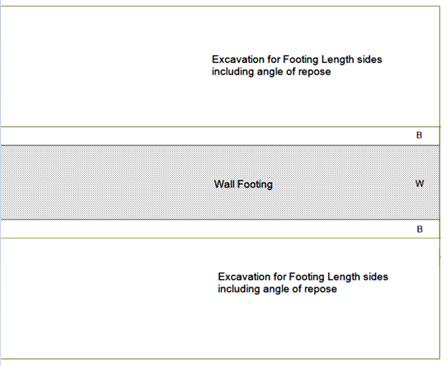
Now let’s view a section through the same footing.
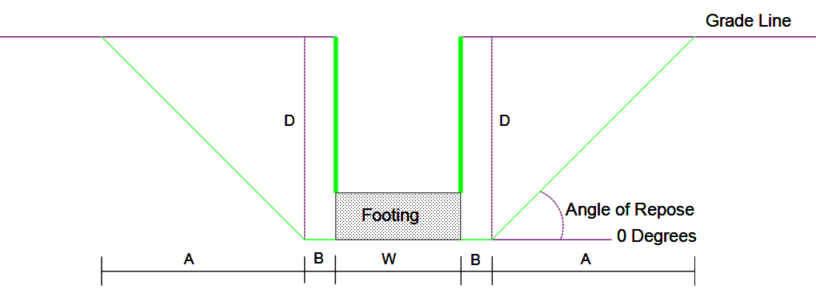
Excavation Calculations Along Wall Footing Sides
Example 1
In this example, the angle of repose is 45 degrees. Therefore, A and D are the same length. The footing length is 1 LF:
If A = 6.5’, B = 1’, W = 4’, and D = 6.5’
Then ((B + W + B) + (1/2A + 1/2A)) * D * Footing Length = Excavation
Or ((1 + 4 + 1) + (.5 * 6.5) + (.5 * 6.5))) * 6.5 * 1
= 81.25 CF per LF (or approx. 3.01 CY/LF)
Example 2
If the angle of repose is 60 degrees, then you calculate A as follows:
A = D / Tangent of 60 degrees
This is 6.5 / 1.732050808, or 3.75277675
So, using the same formula:
((1 + 4 + 1) + (.5 * 3.75277675) + (.5 * 3.75277675)) * 6.5 * 1
Or (6 + 3.75277675) * 6.5
Or 9.375277675 * 6.5
= 63.39 CF per LF (or approx. 2.35 CY/LF
Calculations if Angle of Repose Does Not Begin at the
Footing Bottom
In some cases, the code allows you to begin angle of repose a certain height above the footing bottom. In the example above using 45 degree angle of repose, let’s say the footing bottom was really 10.5’ (instead of 6.5’) below the surface. That would add considerable excavation quantity. However, if you were permitted to begin angle of repose 4’ from the bottom, it would add some, but much less. The diagram would look like this:
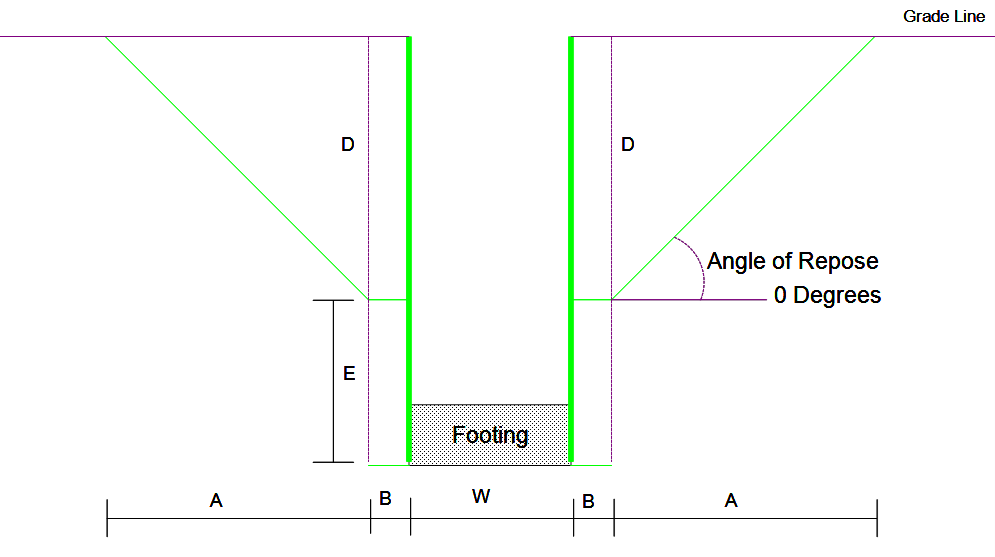
Revised Example 1
In Example 1 above, the depth to the top of footing is 5’ for an overall depth including footing of 6.5’. In this example, use a depth to the top of footing of 9’ with an overall depth of 10.5’. Also, begin the angle of repose 4’ up from the bottom of the footing.
From results of Example 1: = 81.25 CF per LF (or approx. 3.01 CY/LF)
Now add the calculation from the new bottom to 4’ straight up.
Add to that the portion below the angle of repose:
(B + W + B) * E * Footing Length (We are using 1LF of footing for this illustration)
Using the previous values, with E being 4’:
(1 + 4 + 1) * 4 = 24 CF (approx. .89 CY per LF)
Adding the previous values to this gives us 81.24 + 24 = 105.25 CF / 27 = approx. 3.90 CY per LF
Wall Footing Length at Ends
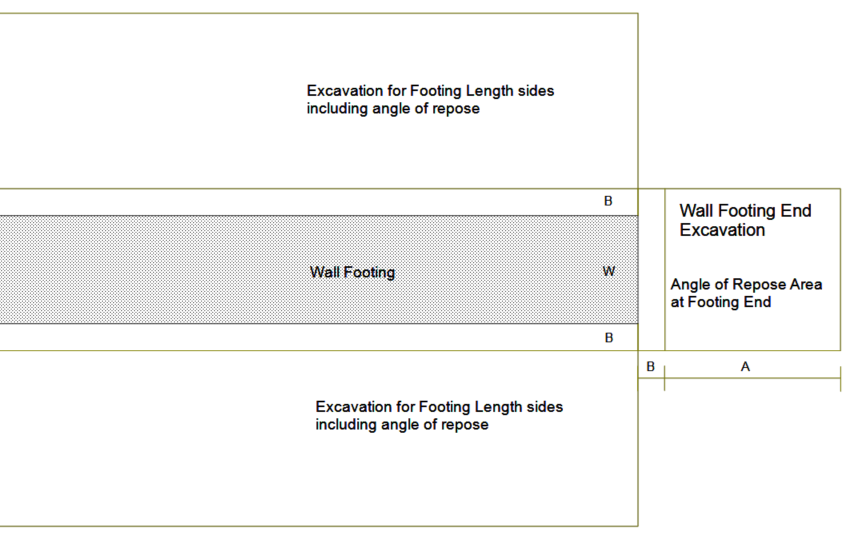
Side View of Footing End
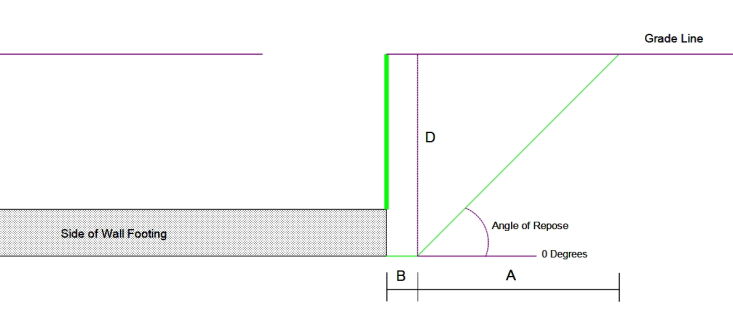
Calculations for Footing End Excavation
End Example 1
In this example, the angle of repose is 45 degrees. Therefore, A and D are the same length:
If A = 6.5’, B = 1’, W = 4’, and D = 6.5’
Then (B + 1/2A) * (B + W + B) * D * number of footing ends = Excavation at end
Or (1+ (.5 * 6.5) * (1 + 4 + 1)) * 6.5 =
Or 4.25 * 6 * 6.5 = 165.75 CF / 27 = approx. 6.14 CY per end
End Example 2
If the angle of repose is 60 degrees, then you calculate A as follows:
A = D/Tangent of 60 degrees
This is 6.5 / 1.732050808, or 3.75277675
Therefore, using the same formula:
If A = 3.75’, B = 1’, W = 4’, and D = 6.5’
Then (B + 1/2A) * (B + W + B) * D * number of footing ends = Excavation at end
Or (1 + (.5 * 3.75) * (1 + 4 + 1)) * 6.5 =
Or 2.875 * 6 * 6.5 = 112.125 CF / 27 = approx. 4.15 CY per end
To Add Any Additional at Ends Below the Angle of Repose
The illustration below shows what can and cannot be calculated at the ends. In other words, the portion below the angle of repose for “Begin Angle of Repose__ from bottom.”
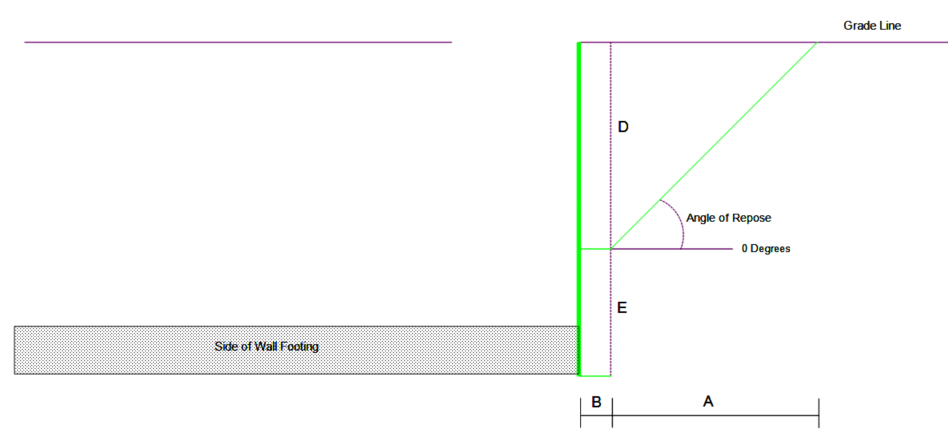
In this illustration, add to the excavation as follows:
(B + W + B) * B * E
Using the previous values of Example 1, with E being 4’:
(1 + 4 + 1) * 1 * 4 = 24 CF (approx. .89 CY per end)
Adding the previous values from End Example 1 to this gives us:
165.75 + 24 = 189.75 CF / 27 = approx. 7.03 CY per end.
Column Footing Count Excavation
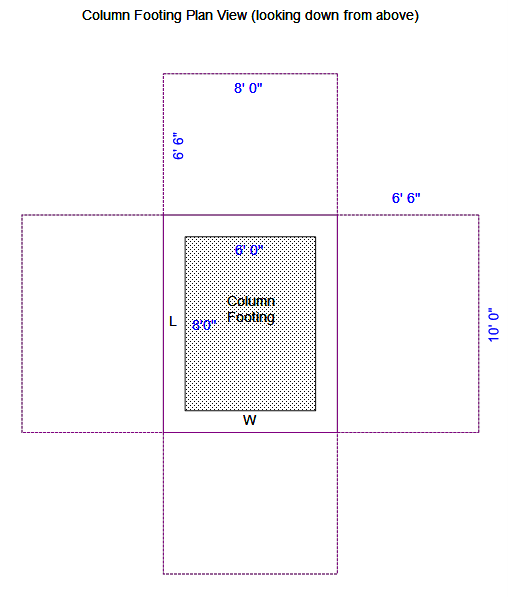
Column Footing Excavation Side View
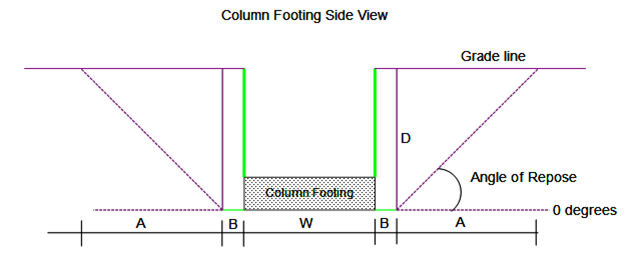
All calculations below are based on two width sides and two length sides for one footing.
In this example, the angle of repose is 45 degrees. Therefore, A and D are the same length:
If A = 6.5’, B = 1, W = 6’, and D = 6.5
Flat bottom excavation (W+B*2) * (L+B*2) =
(6 + 2) * (8 + 2) = 80 SF
Side at angle of Repose
8 * 6.5 / 2 * 2 sides = 52 SF (Width sides)
10 * 6.5 / 2 * 2 sides = 65 SF (Length sides)
Therefore, 80 + 52 + 65 = 197 SF
197 * 6.5 (depth) = 1280.5 CF/ 27 = 47.43CY
If angle of repose is 60 degrees, then you calculate A as follows:
A = D / Tangent of 60 degrees
This is 6.5′ / 1.732050808, or 3.75277675′
Side at angle of Repose
8 * 3.75 / 2 * 2 sides = 30 SF (Width sides)
10 *3.75 / 2 * 2 sides = 37.5 SF (Length sides)
Therefore, 80 + 30 + 37.5 = 197 SF
147 * 6.5 (depth) = 958.75 CF / 27 = 35.51 CY
Also, if Begin Angle of repose is 4′ and the overall depth was 10.5 (instead of 6.5’), then (B + L + B) * (B + W + B) * 4 gets added to above (320 / 2 7= 11.85 CY)
